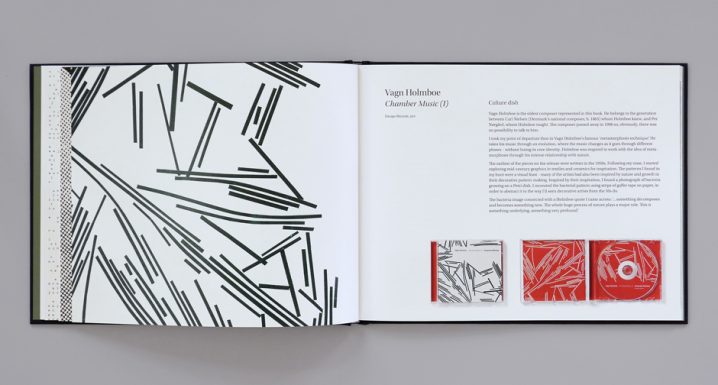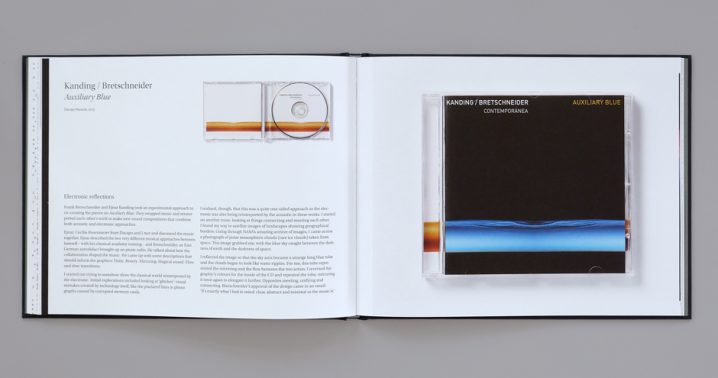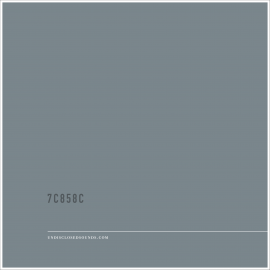
Over the last 10 years, Copenhagen-based graphic designer Denise Burt has been on a unique discovery of contemporary classical music through her work designing covers for hundreds of art music releases. In Seeing New Music she tells, from a personal viewpoint, the stories behind the creation of 24 of her CD designs. She also explains how – starting out as a music novice – she learnt to enquire and engage with the ideas behind the often complex music, in order to create more meaningful designs. The following is an excerpt from the introduction in this book, subtitled Contemporary classical music through the eyes of a graphic designer, which I felt compelled to share with you. Republished with permission.
Just because I’m a graphic designer working with new music, don’t think that I’m an expert in classical music. I’m a graphic designer for a reason – my tendency is towards visual things.
I came to work with new music by chance, having no knowledge or real experience of it. My lack of music education made me timid, so for many years I accepted that the graphics were just a superficial part in the process of publishing music. As I began to get to know the composers and musicians, I realized that I was missing out on an incredible opportunity to work with great artists. I started to engage with the ideas behind the music.

These days when I make a design for a CD release, I have a conversation with the composer or artists involved, if that’s possible, and ask lots of questions. Art music is often based on complex ideas and it’s important to get a good understanding of them in order to make a meaningful design. At the same time, my intuition is always at play. I use the composer or artists’ ideas as a springboard to create a visual that is informed by my own experience of the ideas and music.
Inviting composers and musicians into the design process can be a great inspiration and the very best way of gaining insight. But it also has its dangers – the music is close to the hearts and it can be hard for them to ‘see’ it through others’ eyes. That makes my job much more difficult – there is always the question of who should control the design: the graphic designer, the recording artists or the recording label. It can be a tricky three-way balancing act.

The CD has been – and still is – the main format for recorded music in all the time I’ve been designing. Budgets for releasing art music are famously small, so any deviation from standard formats, such as jewel cases and card wallets, are few and far between.
There is very little space on a CD, so all the available surfaces in the packaging are important. The most important area is, of course, the 120 x 120 mm square of the front cover. The part that shows its face to the world before the CD is opened and the only aspect you tend to see in print or digitally. The cover is the identifier for the music, but the small square doesn’t easily allow for complex visual ideas – it demands something simple and immediate.

As I’m putting this book together, I’m very much aware that the CD is seen as an anachronism. I’ve been repeatedly told over the years that the CD is dead and yet I still find myself making hundreds of them. I don’t worry any more about them becoming obsolete. What interests me is not the format itself but the challenge of finding a way to represent and communicate complex music to potential new audiences. It’s the ultimate design task to try and make someone understand something about a piece of music before the have heard it. If the graphics resonate as part of the experience after they have heard the music, then I have done my job well.
I’ve learned that finding a good solution is a process and you have to trust it. It helps if you are able to listen to others, stand up for your own ideas when challenged, are willing to accept that your impressions are not always right and are prepared to put in extra time when the solution isn’t easily come by. I’m often challenged on all fronts when working with contemporary music, which is probably why it has held my fascination for so many years.

I have selected 24 releases for this book. For each release I tell the story of how the cover artwork came to be. Together, the stories describe the unique journey I’ve been on through the fascinating world of new music and how the experience of working with such a diverse range of recording artists has developed me as a graphic designer.
– Denise Burt
Denmark: 5th March 2015 | available on dacapo-records.dk
UK: 1st April 2015 | pre orders available on amazon.co.uk
USA: 12th May 2015 | pre-orders available on amazon.com





